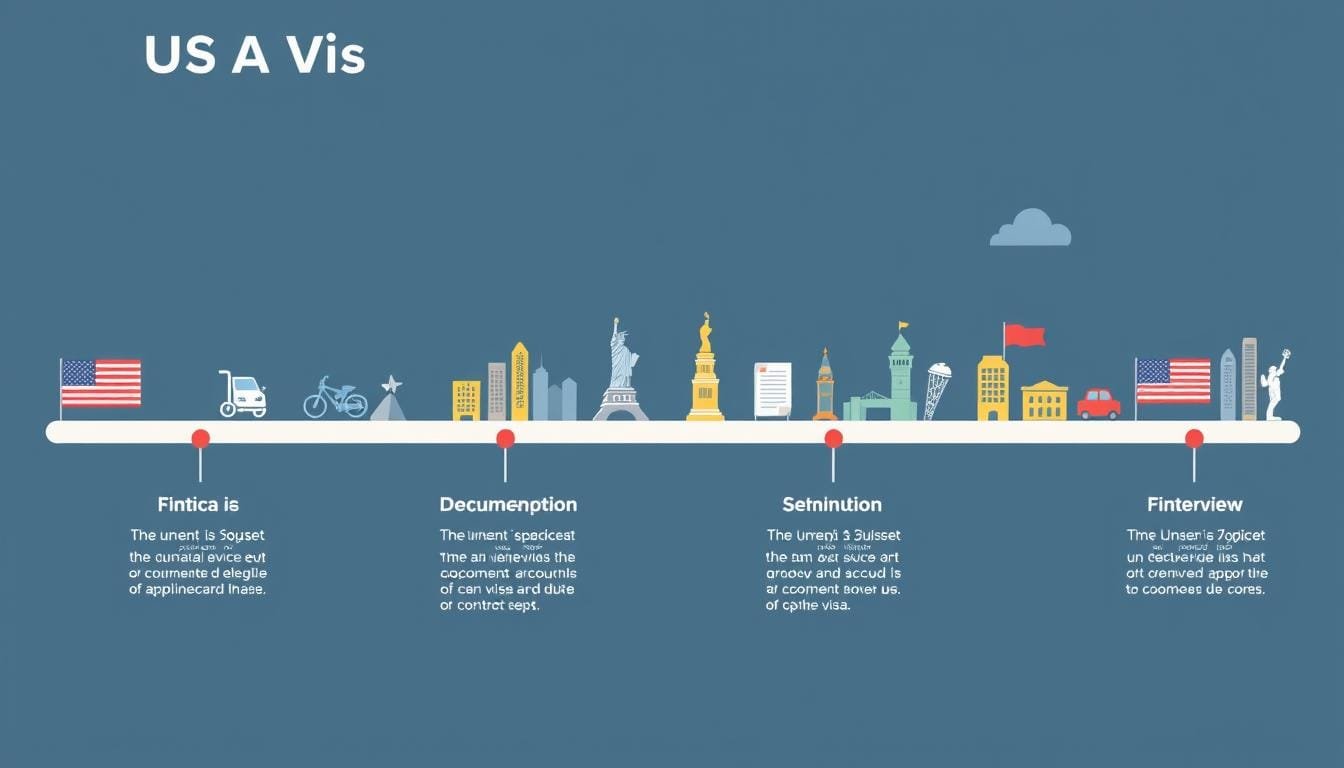Getting a USA visa can be tricky. The time it takes varies a lot. It depends on the visa type, where you are, and how many applications there are.
Waiting times for a USA visa can be short or long. For example, in Abidjan, it’s 93 days for a tourism visa. But in Abu Dhabi, it’s only 34 days. In Accra, study visas take 87 days, but in Algiers, it’s just 2 days.
Even after the interview, there’s more waiting. It usually takes a few business days to get your visa printed. In Hong Kong, it takes two days to get your documents. From Macau, it’s four days.
This is just the beginning of your visa journey. The actual time can change a lot. It depends on your situation and the center’s workload. Stay patient and plan well for a smooth process.
USA visa processing time

The time it takes to get a US visa can change a lot. Knowing how long it takes to get a visa can help you plan better.
Regular processing timeline
Most US visas take 3-8 months to process. This time can change based on the visa type and how many applications there are. Interview waivers can take up to three weeks.
Premium processing option
For some visas, you can pay $2,500 for premium processing. This makes your visa application faster, taking just 15 days.
Wait times by visa category
Visa wait times vary by type. For example, B1/B2 visas can take 2 days to over 800 days. Student visas (F/M/J) are usually faster. About 60% of B1/B2 renewals from Nigeria get an interview waiver, taking 2-3 weeks.
USCIS processing centers and timelines
USCIS centers process visas at different speeds. You can check their website for details. Processing times depend on the case’s complexity, how many applications there are, and the center’s staff.
| Visa Type | Regular Processing | Premium Processing | Interview Waiver |
|---|---|---|---|
| B1/B2 Visitor | 2-800+ days | Not available | 2-3 weeks |
| F/M/J Student | Shorter than B1/B2 | Not available | Not applicable |
| Work Visas (eligible) | 3-8 months | 15 calendar days | Varies |
Visa Application Process Steps and Duration
Getting a U.S. visa has many steps. Each step can cause delays. Knowing these steps helps you deal with visa backlogs better.
Petition Preparation Phase
The first step is getting your petition ready. This can take 1-6 months. It depends on the visa type and how complex it is.
For temporary worker visas, your employer must file Form I-129 with USCIS. The cost varies:
- B1/B2 and student visas: $185
- H, L, O, P, Q, and R visas: $205
- E category visas: $315
- K visas (fiancé(e) or spouse): $265
USCIS Review Period
After you submit your petition, USCIS reviews it. Regular processing takes several months. Premium processing is faster, taking 15 days.
This stage often causes delays in getting your visa.
Interview Scheduling and Wait Times
When USCIS approves your petition, you’ll schedule an interview. Wait times vary by location and visa type. They can range from days to over a year.
Post-Interview Processing
After your interview, it takes a few business days for final processing. Some applicants may need to meet extra requirements. For example, certain exchange visitors must spend two years in their home country.
Remember, fees are non-refundable. Some nationalities may also pay extra fees.
| Visa Type | Application Fee | Processing Time |
|---|---|---|
| B1/B2 (Visitor) | $185 | 3-5 months |
| H-1B (Skilled Worker) | $205 | 6-8 months |
| K-1 (Fiancé(e)) | $265 | 6-9 months |
| E (Treaty Trader/Investor) | $315 | 2-4 months |
Conclusion
Understanding the USA visa process is important. It can be complex, but knowing the timelines helps. In 2023, the U.S. issued over 10.5 million visas, beating pre-pandemic numbers.
This shows the U.S. is working hard to make things faster. Wait times have gone from 200 days to 140 days. This is a big improvement.
For those applying for a visa, 40% didn’t need an in-person interview. This makes things quicker. The U.S. is also testing a paperless visa program.
High-skilled workers, students, and temporary workers got a lot of visas. This shows the U.S. is still a top choice for many.
As visa rules change, it’s important to stay updated. Being ready and starting early can help a lot. With the right info, getting a U.S. visa can be easier than you think.



